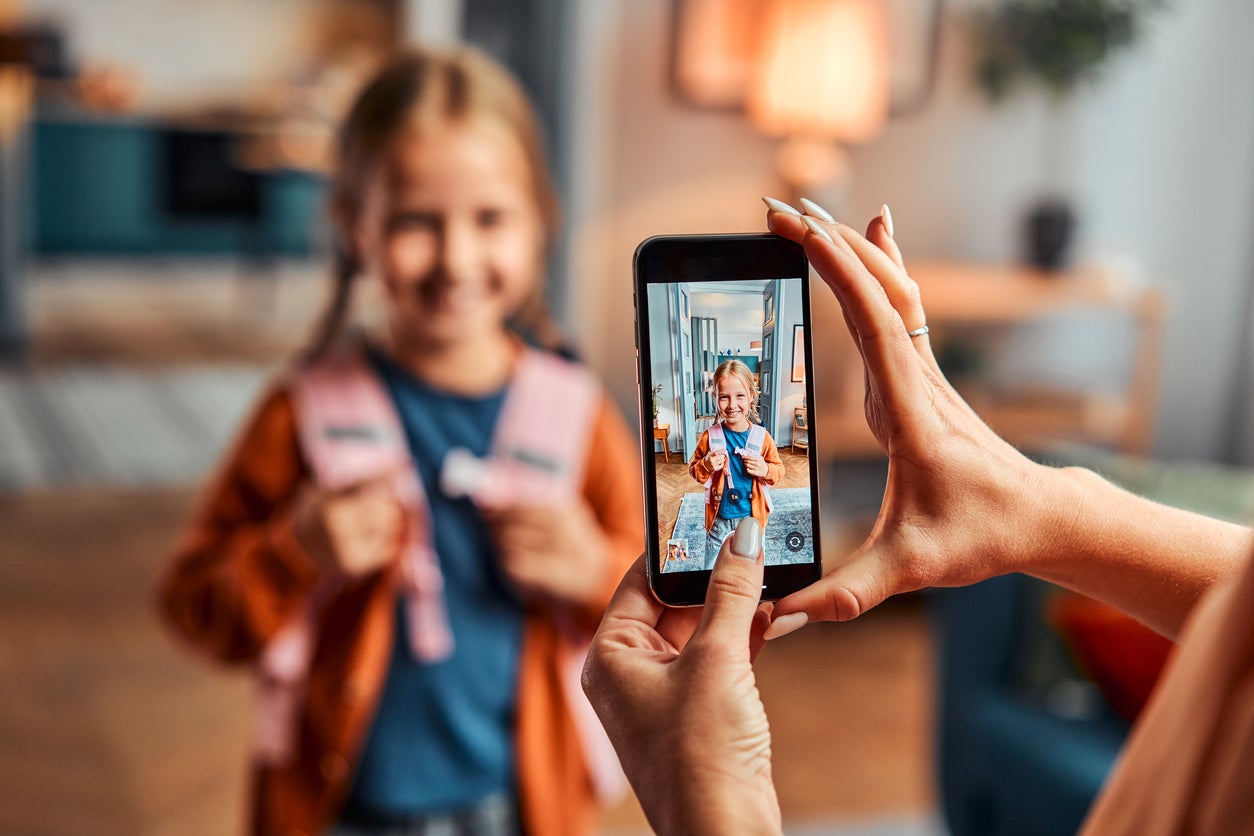To post your kids or not to post your kids? It’s a very modern – and very contentious – parenting conundrum. For every mum or dad that chooses to digitally document every stage of their tiny darling’s life in near-forensic detail, you’ll find a social media refusenik whose children are entirely absent from their online footprint. For others, though, there’s a third option. They’ll share photos of their offspring, yes, but – and here’s the crucial bit – they’ll obscure the kids’ features entirely by popping an emoji over their faces.
The go-to emoji for the job? Inevitably, it tends to be the baby, with its wide eyes, tiny curl of hair and slightly uncanny grin, although a heart (available in almost every colour of the rainbow) is another popular option. And if your little angels are behaving more like little monsters? There’s always the demon emoji.
The appeal, of course, is having your cake and eating it. Emoji-fying your children is a way to provide an insight into what you and your (doubtless very cute) family are up to, without plastering their features all over the internet in perpetuity. In theory, you get to proudly share dispatches from daily life (and experience the dopamine rush that comes when the likes and comments roll in) while also shielding the youngsters from the ills of social media. You can navigate the push-pull between your friends’ and family’s desire to keep up with your little ones and your own creeping concerns about privacy, with just a few taps of your smartphone screen.
Sounds like a win-win, right? No wonder, then, that it’s becoming such a ubiquitous practice. Now that I’m in my thirties, my social media feeds are filled with birth announcements, but spotting an actual human baby in any of these posts is something of a rarity. I’m far more used to seeing cartoonish renderings of infants plonked onto otherwise realistic family snaps.
Like so much of our digital behaviour, this trend started out among celebrities and seems to have trickled down to us civilians. The likes of Gigi Hadid, Priyanka Chopra and Blake Lively have all opted to conceal their kids in this way (presumably due to entirely reasonable safety concerns about broadcasting the faces of their children to millions of people around the world).
Earlier this month, Meghan Markle inevitably made headlines when she shared pictures from a trip to Disneyland, hiding six-year-old Archie and four-year-old Lilibet with an orange and a pink heart respectively (her behaviour was criticised as “attention seeking” in some quarters, which doesn’t seem particularly fair; presumably she’d have garnered yet more bile if she’d gone without the emojis). Even Mark Zuckerberg blocks out his older daughters’ faces when he posts them online. There is, of course, a certain irony implicit in the king of Facebook suddenly coming over all coy about digital privacy.
But is this approach really the solution to all your concerns about “sharenting”? Apologies for being the bearer of bad news, but the answer is a resounding… no. “I need to be brutally honest here: putting an emoji over a child’s face provides virtually no real privacy protection whatsoever,” explains Lisa Ventura, an award-winning cybersecurity specialist and the founder of Cyber Security Unity. Instead, she adds, “this approach is more security theatre than actual security” – in other words, it’s a way of performing your concerns about privacy, rather than doing anything truly meaningful to address them. Essentially, it might be a gesture that’s more about the parents than the kids.
The main problem, Ventura says, is that “even with the face obscured, you’re still sharing massive amounts of identifiable information” about your kid. Posted a photo of them in uniform with the logo or crest visible? Your followers can now work out where they go to school every day. Even without the face on show, it’s still possible to glean details such as their “approximate age, build [and] location data from the photo”, Ventura adds – and “it all builds a profile”.
It might seem alarmist, but the sheer volume of information that a casual observer can pick out from your social media profile is staggering. Adding timestamps relating to your daily routine, such as documenting the school run on an Instagram Story, for example, can be another way of inadvertently broadcasting details that would be better kept private. And it’s not just fellow users you need to consider, but the digital platform that you’re using. “Every photo you upload trains facial recognition algorithms and builds advertising profiles,” Ventura notes.

There’s a lot of conflicting information doing the rounds online about whether or not you can actually “remove” an emoji that has been placed on an image. “There’s a lot of scaremongering about AI being able to magically reconstruct faces from emoji-covered photos,” Ventura says, as well as various digital tools that claim to be able to get rid of this layer. For the most part, though, when the image gets saved, the original will be overwritten; you can’t see “behind” it.
So the main issue isn’t the threat of peeling away the emoji, but the fact that “most parents aren’t just posting one carefully emoji-protected photo,” Ventura adds. “They’re sharing multiple images over time, and the combined data from all those posts creates a much bigger privacy concern than any single image.” And if popping some cartoonified masks onto their faces makes you more laissez-faireabout what you’re posting about your kids, it could, in fact, be counterproductive.
Of course, none of this is to suggest that you’re a bad parent for doing this. Being proud of your kids ishardly a sin. And choosing how much to share online is a highly personal decision, one that might be influenced by a whole array of factors. Perhaps you’re living thousands of miles away from your extended family, and want them to feel like they’re involved in your children’s lives. Or maybe you’ve just got pushy in-laws who don’t understand your concerns and want to be able to share photos of their beloved grandkids with their Facebook pals. “Sharing joy is such a natural human instinct,” says Ventura, who says she can “completely understand” why parents do this: “They want to share those precious moments, the first steps, birthday parties, family holidays.”
Using an emoji as a shield, Ventura adds, “feels like a compromise because it allows parents to maintain that social connection” while also “giving them the psychological comfort that they’re taking some sort of protective measure”. Even the fact that it shows the parents are thinking about privacy is important, she notes, as a “first step towards better digital hygiene”. But the overall effect is much like a sticking plaster: “It might make you feel like you’re doing something, but it’s not actually addressing the underlying issue.”
So what should we really be bearing in mind before posting? Ventura recommends asking yourself “What story does this photo tell?” as a starting point, considering details such as “the metadata, the background details [and] the patterns over time” (such as school run or birthday posts). Even reflective surfaces “might show things you didn’t intend”, she adds. And if you want to share photos with family, Ventura suggests considering shifting to a private group rather than a public platform. Avoiding posting when you’re annoyed with your child is alsorecommended. A snap of a toddler having a meltdown might seem cute right now, “but how will they feel about that being online when they’re 16?” she asks.
Another rule of thumb? “If you wouldn’t hand a physical copy of that photo to a complete stranger in the street, don’t post it online,” she adds. “Because that’s essentially what you’re doing, except that stranger might be able to keep it forever, or worse, use it in unauthorised ways you did not intend.”
When her two children were younger, cybersecurity strategy manager Bharti Lim used to share photos unencumbered, but she’s since changed tack entirely. Now, she takes a more analogue approach to obscuring her kids’ identities. “You often see the back of their heads in photos that are shared, or their face is obscured in some way with things like hats, swim goggles or them not quite facing the camera,” she says, to make sure “that the face is too hard to make out”, and that what’s covering it is “baked into the original photo when taken so it cannot be removed by any software hacks”.
She also avoids uploading videos in which they’re talking: “Generative AI is amazing at what it can produce, but it can also be used for the wrong things, and I don’t want my children to be used as a source until they are ready to make this decision for themselves.”
And therein lies the thorniest issue. Children can’t really consent to having their lives splashed around the internet, with or without emoji cover. And once photos of them are uploaded, they’re effectively preserved in digital amber. “Children deserve to have that right protected until they’re old enough to make informed decisions about their own digital footprint,” Ventura says. “It might mean missing out on some likes and comments, but protecting our children’s future autonomy might just be worth that sacrifice.”







